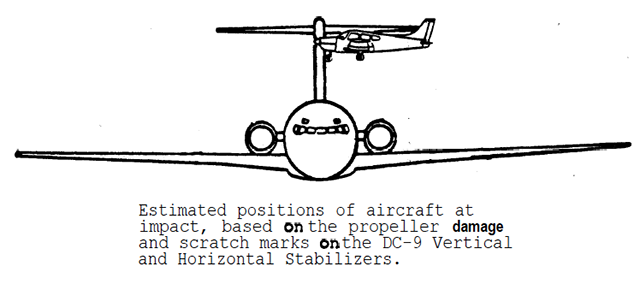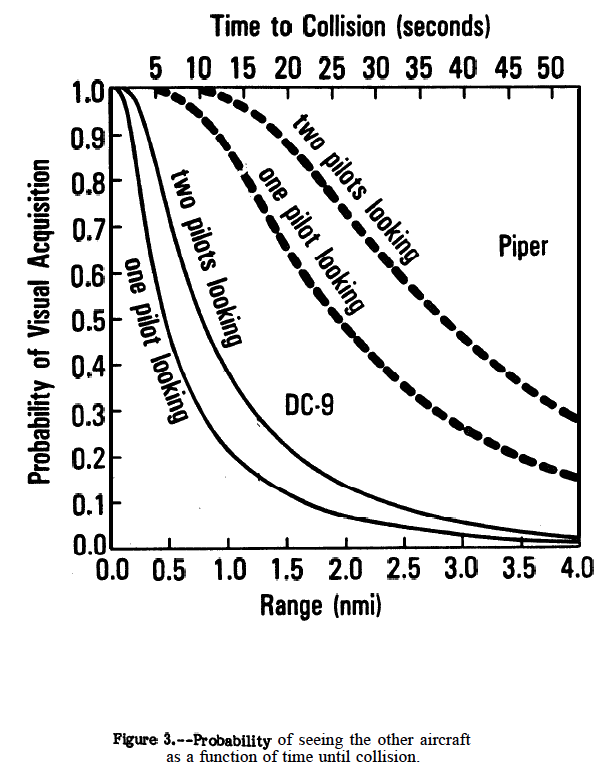Just because you are on an IFR flight plan doesn't mean you have the sky to yourself, as this mishap clearly illustrates. The Aeroméxico aircraft was technically in the right but all aboard perished after a light aircraft encroached on their airspace. The "See and Avoid" concept was found causal, as well as the light aircraft. But sometimes your last line of defense — your eyes — is the only defense you have left.
— James Albright

Updated:
2015-04-23
A lot has happened over the last 20+ years with the mandatory inclusion of TCAS on most aircraft. The problem remains, however, because still not everyone has TCAS. On a VMC day when low to the ground, one pilot's eyes have to be outside. When there is a mix of traffic and not everyone is playing by the IFR rules, you need to have your head on a swivel, your eyes outside the cockpit. Every pilot should know the Big Sky Theory doesn't work.

1
Accident report
First Aircraft:
- Date: 31 AUG 1986
- Time: 11:52 PDT
- Type: McDonnell Douglas DC-9-32
- Operator: Aeroméxico
- Registration: XA-JED
- Fatalities: 6 of 6 crew, 58 of 64 passengers, 15 on the ground
- Aircraft Fate: Destroyed
- Phase: Approach
- Airports: (Departure) Tijuana-Rodriguez Airport (TIJ / MMTJ), Mexico; (Destination) Los Angeles International Airport, CA (LAX / KLAX), United States of America
Second Aircraft:
- Type: Piper PA-28-181 Cherokee
- Operator: Private
- Registration: N4891F
- Fatalities: 1 of 1 crew, 2 of 2 passengers
- Aircraft Fate: Destroyed
- Phase: En route
- Airports: (Departure) Torrance, CA, (TOA / KTOA) United States of America; (Destination) Big Bear, CA, (L35) United States of America
2
Narrative
On August 31; 1986; about 1152 Pacific daylight time; Aeronaves de Mexico, §.A., flight 498, a DC-9-32, Mexican Registration XA-JED, and a Piper PA-28-181, United States registration N4891F, collided over Cerritos, California. Flight 498, a regularly scheduled passenger flight, was on an Instrument Flight Rules flight plan from Tijuana, Mexico, to Los Angeles International Airport, California, and was under radar control by the Los Angeles terminal radar control facility. The Piper airplane was proceeding from Torrance, California toward Big Bear, California, under Visual Flight Rules, and was not in radio contact with any air traffic control facility when the accident occurred.
Source: NTSB Accident Report 87/07, page v.
The controller was busy admonishing a third airplane for blundering into another region of the airspace and missed the radar "skin paint" return of the Piper.
- The collision occurred inside the Los Angeles Terminal Control Area near 6,560 feet mean sea level. At the time of the collision, the sky was clear, and the reported visibility was 14 miles. The air traffic controller providing service to flight 498 did not observe the Piper airplane's radar return on his display and therefore did not provide any traffic advisory to flight 498 concerning the location of the Piper airplane before the collision.
- Both airplanes fell to the ground within the city limits of Cerritos. Five houses were destroyed and seven other houses were damaged by airplane wreckage and postimpact fire. Fifty-eight passengers and six crew members on the DC-9 were killed; the pilot and 2 passengers on the Piper were killed; 15 people on the ground were killed and 8 others received minor injuries.
Source: NTSB Accident Report 87/07, page v.
3
Analysis
- The airplanes collided at a 90° angle, at an altitude of about 6,560 feet, and in visual meteorological conditions. The collision occurred inside the Los Angeles TCA.
- Both pilots were required to see and avoid the other airplane. There was no evidence that either pilot tried to evade the collision.
- The pilot of the Piper was not cleared to enter the Los Angeles TCA. His entry was inadvertent and was not the result of any physiological disablement.
- The unauthorized presence of the Piper in the TCA was a causal factor to the accident.
- The positions of the Piper were displayed on the AR-l controller's display by, at the least, an alphanumeric triangle; however, the Piper's primary target may not have been displayed or may have been displayed weakly due to the effects of an atmospheric temperature inversion on the performance of the radar. The analog beacon response from the Piper's transponder was not displayed because of the equipment configuration at the Los Angeles TRACON.
- The AR-l controller stated that he did not see the Piper's radar return on his display, and, therefore, did not issue a traffic advisory to flight 498. His failure to see this return and to issue a traffic advisory to flight 498 contributed to the occurrence of the accident.
- The Los Angeles TRACON was not equipped with an automated conflict alert system which could detect and alert the controller of the conflict between the Piper PA-28 and flight 498.
Source: NTSB Accident Report 87/07, ¶3.1
4
Cause
The National Transportation Safety Board determines that the probable cause of the accident was the limitations of the air traffic control system to provide collision protection, through both air traffic control procedures and automated redundancy. Factors contributing to the accident were (1) the inadvertent and unauthorized entry of PA-28 into the Los Angeles Terminal Control Area and (2) the limitations of the "'see and avoid" concept to ensure traffic separation under the conditions of the conflict.
Source: NTSB Accident Report 87/07, page v.
Back in 1986 many of us gave too much credit to our IFR flight plans to provide protection from itinerant aircraft blundering into our flight paths. Now with TCAS, many of us rely on the electronic negotiation between aircraft for the same "warm and fuzzy." But TCAS relies on the other aircraft being so equipped and its pilots reacting correctly to its warnings. Your last line of defense remains your eyes. This accident spurred a study on pilot scanning techniques and reaction times. If you are in a traffic pattern environment, IFR or VFR, your eyes need to be outside. The study shows this practice can make a critical difference.
More about this: The Big Sky Theory.
References
(Source material)
NTSB Aircraft Accident Report, AAR-87/07, Collision of Aeronaves de Mexico, S.A., McDonnell Douglas DC-9-32, XA-JED and Piper PA-28-181, N4891F Cerritos, California, August 31, 1986

